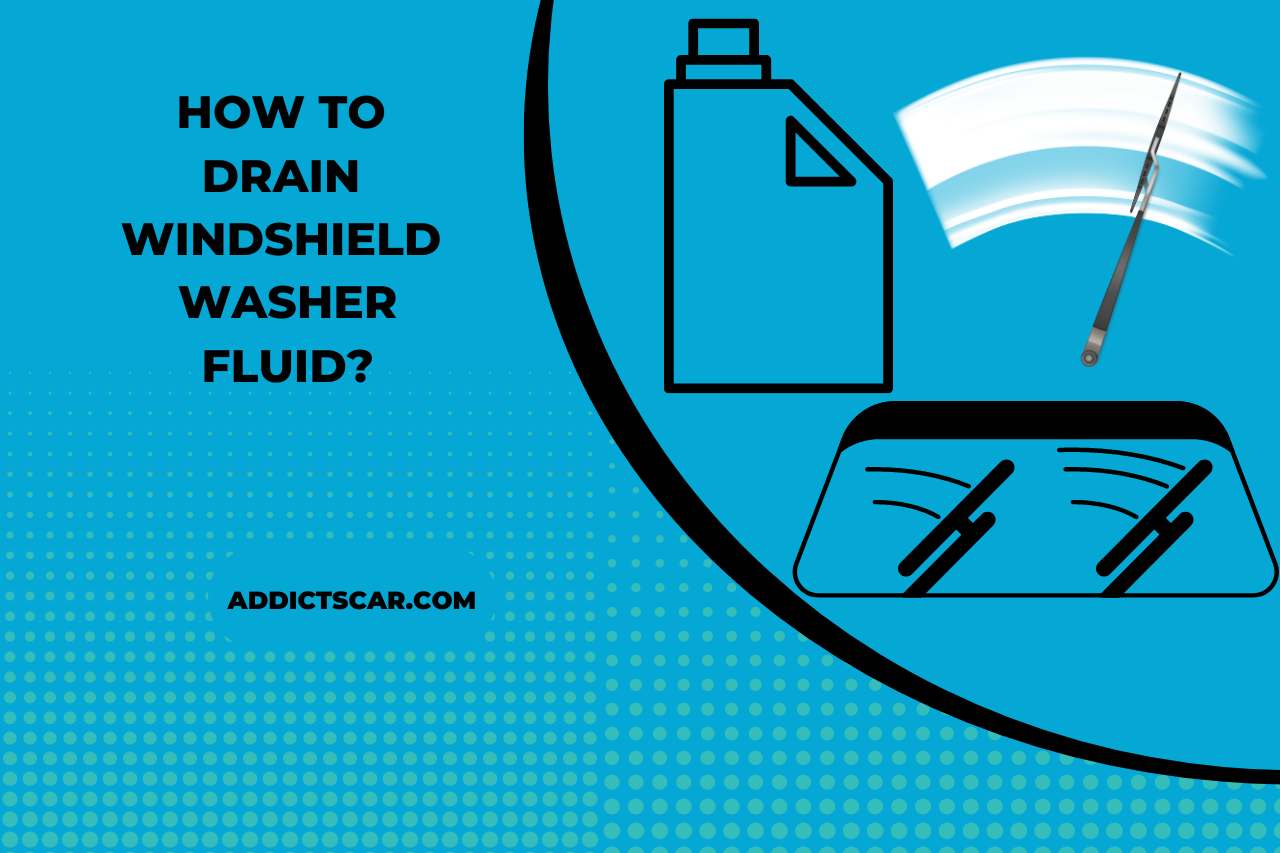How to Drain Windshield Washer Fluid? (Step-by-Step Guide)
Draining windshield washer fluid is a simple task ensuring your vehicle’s washing system runs smoothly. How to drain windshield washer fluid? Whether you need to refill the fluid or prepare your vehicle for storage or maintenance, this article will show you how to properly drain the windshield washer fluid. Following the instructions above, you can do this while keeping your vehicle’s windshield washer system operational.
Should I Drain the Windshield Washer Fluid?
If you reside in a location with high-temperature variations, draining the windshield washer fluid before winter can help prevent freezing. Freezing fluid can harm the washer system and make visibility difficult.
Draining the fluid can assist in avoiding spills and make the procedure easier while doing maintenance or repair jobs that require accessing components near the washer fluid reservoir.
If the windshield washer fluid has been contaminated or sitting in the reservoir for an extended period, draining it and replacing it with new fluid will restore ideal performance and cleanliness.
If you plan to park your vehicle for an extended period, draining the windshield washer fluid will keep the fluid from degrading and perhaps causing problems when you restart the system.
Draining the fluid may not be necessary if you use a windshield washer fluid formulation appropriate for the current season and temperature circumstances.
Finally, your circumstances and preferences influence the decision to drain the windshield washer fluid. To assess if draining the fluid is essential or advantageous for your circumstance, consider aspects such as climate, maintenance routine, and any upcoming maintenance or repair chores.
What are these Signs that I Need to Drain Windshield Washer Fluid?
The washer fluid is most likely contaminated if it seems hazy, discolored, or has debris floating. Dirt, dust, algae growth, and other pollutants can all cause contamination This can occur if low-quality fluid or water has been used, creating a breeding habitat for bacteria.
In such cases, draining and refilling the fluid can aid in the elimination of the odor-causing substances. If you reside in a cold climate, using washer fluid with a suitable antifreeze content is critical.
If your present fluid lacks antifreeze characteristics or has insufficient concentration, it may freeze in the reservoir or on the windshield. In such circumstances, draining and replacing the fluid with a suitable winter washer fluid is advised.
If you intend to park your vehicle for a lengthy period, drain the windshield washer fluid. The stagnant fluid left in the reservoir for an extended period might deteriorate, get polluted, or grow mold and germs.
Draining and replenishing the fluid before storage ensures a fresh start when you restart the system.
How Long does Washer Fluid Last?
The lifespan of windshield washer fluid varies based on factors such as fluid quality, ambient conditions, and frequency of use.
Generally, windshield washer fluid has a relatively long shelf life when properly maintained and unopened. If the washer fluid container is kept closed and unopened, it can keep its effectiveness intact for a long time, generally up to two years or more.
However, always check the expiration date stated on the container for precise recommendations. When a container of washer fluid is opened, its shelf life may be reduced due to the possibility of contamination and air exposure.
Opened washer fluid may deteriorate or become less effective over time. It is best to utilize available washer fluid within a year or as the manufacturer directs.
Environmental factors such as severe temperatures and sunlight exposure can reduce the longevity of the washer fluid.
High temperatures can cause evaporation and impair the efficacy of the fluid while freezing temperatures might cause fluid expansion and potential washer system damage. It is critical to select a washer fluid formulation appropriate for the current environmental circumstances.
The frequency you use your windshield washer system might also affect the fluid’s longevity.
Regular use keeps the fluid moving and prevents stagnation. If the washer fluid is turned in for an extended period, it may become sluggish, gather dirt, or become more prone to contamination.

Can I Drain Windshield Washer Fluid on My Own?
Prepare a container to collect the draining fluid, gloves to protect your hands, and, depending on the drainage method, a screwdriver or pliers. It’s usually a plastic jar with a cap labeled with a windshield emblem or “Washer Fluid.”
Underneath the washer fluid reservoir, place an appropriate receptacle, such as a plastic bottle or a drain pan, to catch the draining fluid. Ensure the container has enough capacity to hold the fluid volume in the reservoir.
Look for the drain plug or hose connecting to the reservoir’s bottom. As the fluid empties, you may need to tilt the container or modify its position.
Drain the reservoir until it is empty. Once the fluid has been completely emptied, clean the reservoir and its components as needed.
To remove any residue or buildup, use a light detergent and water. Reattach the drain plug or hose securely, and make sure the reservoir cap is securely closed.
Remember to dispose of the collected washer fluid properly, adhering to any local legislation or recommendations for the disposal of vehicle fluids.
How to Drain Windshield Washer Fluid?
It is typically a clear plastic jar with a cap labeled with a windshield emblem or “Washer Fluid.”Place an appropriate container beneath the washer fluid reservoir, such as a drain pan or a large plastic bottle, to catch the draining fluid. Ascertain if the container is large enough to hold the total fluid volume in the reservoir.
To access the washer fluid reservoir, unscrew or unclip the cap. Look to locate the drainage point near the reservoir’s bottom. Some automobiles have a drain plug, while others have a drainage hose that must be unplugged.
If your car has a drain plug, release it using a tool or pliers and allow the fluid to pour into the collection container. If there is a drainage hose, carefully disconnect it to allow the fluid to flow. Tilt or alter the container’s position to catch all the liquids.
Once the fluid has emptied, clean the reservoir with a light detergent and water if necessary. To remove any residue, carefully rinse it. Reattach the drain plug or securely reattach the drainage hose. If you intend to refill the washer fluid, select a washer solution appropriate for your environment. Pour in the fresh fluid until it reaches the level specified on the reservoir or as advised in your vehicle’s handbook. Screw the cap on tightly.
Dispose of the collected washer fluid following local laws. Most towns and cities have designated recycling or dumping facilities for vehicle fluids.
How Much Viper Fluid Do I Need?
Generally, it’s a good idea to keep at least one gallon of washer fluid on hand for most automobiles. To assess the capacity of the washer fluid reservoir, check the level indicators on the reservoir or refer to your vehicle’s manual.
This can help you estimate how much fluid you need to fill it. Some smaller vehicles may have half a gallon reservoir capacities. Pour the washer fluid cautiously and check the fluid level in the reservoir. To avoid potential overflow or leaks, avoid overfilling.
How Often Should you Refill Wiper Fluid?
When you use your windshield wipers frequently, especially in rainy or snowy weather, you will use more washer fluid. Regular use may necessitate more frequent refilling.
If you frequently drive in dusty or unclean conditions, your windshield may need to be cleaned more frequently.
This can result in more significant washer fluid usage, demanding more frequent refilling. In colder climates, utilizing a winter-specific washer fluid containing antifreeze compounds is critical.
During the winter, you may need to replenish the fluid more frequently to guarantee enough antifreeze protection. Take into account the size of your vehicle’s washer fluid reservoir. Smaller reservoirs will need to be refilled more frequently than larger reservoirs.
How to Put Windshield Fluid in the Car?
Select a windshield washer fluid that is appropriate for your climate and satisfies the manufacturer’s specifications. Washer fluid is available in automotive supply stores and the automotive area of most retail stores.
Locate the windshield washer fluid reservoir under your car’s hood. It is typically a clear plastic container with a cap, frequently labeled with a windshield emblem or titled “Washer Fluid.”To gain access to the opening, unscrew or unclip the washer fluid reservoir cap.
Pour the washer fluid into the reservoir carefully, using a funnel if required. Pour slowly to prevent spillage and overflow. Fill the reservoir to the recommended level, usually marked on the reservoir or noted in the owner’s manual.
Watch this one,
Video Credits – 1A Auto: Repair Tips & Secrets Only Mechanics Know
Continue Exploring: More Articles to Keep You Engaged







